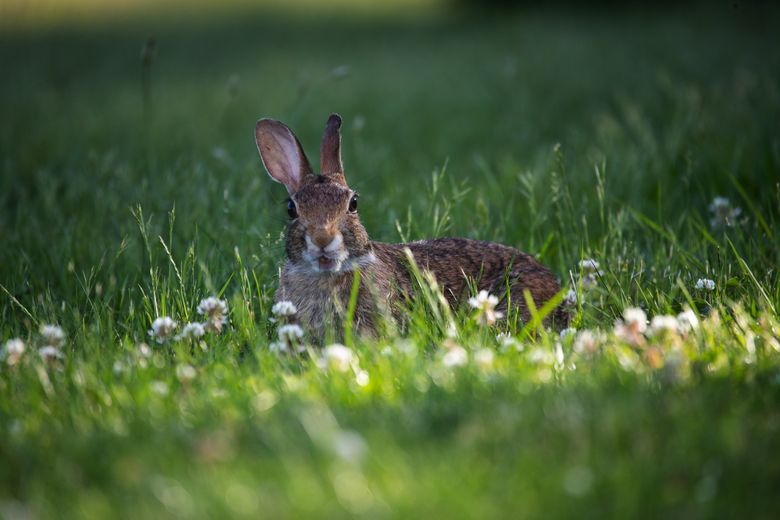
An Eastern cottontail at the University of Washington’s Center for Urban Horticulture goes out on the town for a meal, and to town on the grass, shrubs and more, after a heat wave hit the region in late June. (Ken Lambert / The Seattle Times)
IT’S LATE AFTERNOON in the Olympic Sculpture Park — 9 acres of art and landscaping overlooking Puget Sound — with a classic Seattle mixed-spring sky overhead. One ragged halo of blue hangs above a container ship, but most of the rest is clouds: “Simpsons”-puffy up top, flat and sooty below, like cotton balls that have been used to swab a wet ashtray.
Below is the domain of King Bunny, lord of the local herbivores, currently perched on a carpet of grass and clover, doing his part to mow the lawn. (Biologically speaking, we don’t know if this rabbit is male. But Seattle Art Museum runs the sculpture park, and its facilities and landscape staff has named the creature, so King Bunny it is.)
In coloring (brownish) and shape (fat oval), King Bunny appears to be a well-fed Sylvilagus floridanus, the same Eastern cottontail species as the other rabbits on the lawn — as well as the uncounted thousands, maybe millions, that seem to be in the middle of a population boom across Western Washington. You might have seen a few yourself.
But this rabbit is at least three times as big as the others, each ear sprouting straight up like the tip of a fleur-de-lis, and it seems remarkably self-possessed for a rabbit. People walk past, some with dogs, others stopping to take his picture. King Bunny doesn’t care.
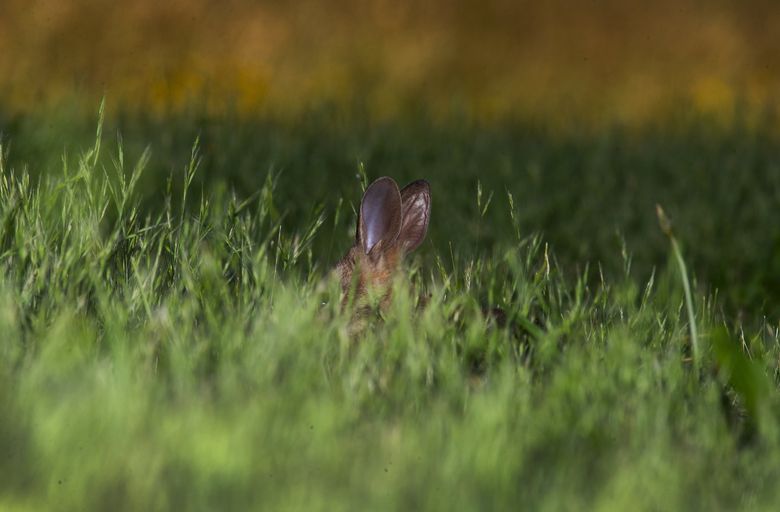
1 of 3 | An Eastern cottontail’s ears go up as it monitors a nearby photographer at the University of Washington’s Center for Urban Horticulture. (Ken Lambert / The Seattle Times)
A boy in overalls, maybe 9 years old, spots him. He peels away from his accompanying adults, making a slow beeline for the big rabbit, hands clenching and releasing, as if his amygdala — that almond-shaped corner of the brain scientists have associated with the perception of cuteness and, perhaps paradoxically, hunting — has taken over.
The rabbit slowly raises its head and, when the boy is just a few paces away, unhurriedly hop-lumbers through a gap in a nearby thicket.
The boy spins, apparently overwhelmed, and squeaks: “Little bunny hidy-hole!” Once he’s gone — back with the grown-ups among the rusty waves of Richard Serra’s “Wake” — the rabbit lopes back out and resumes grazing, the picture of dignified ease.
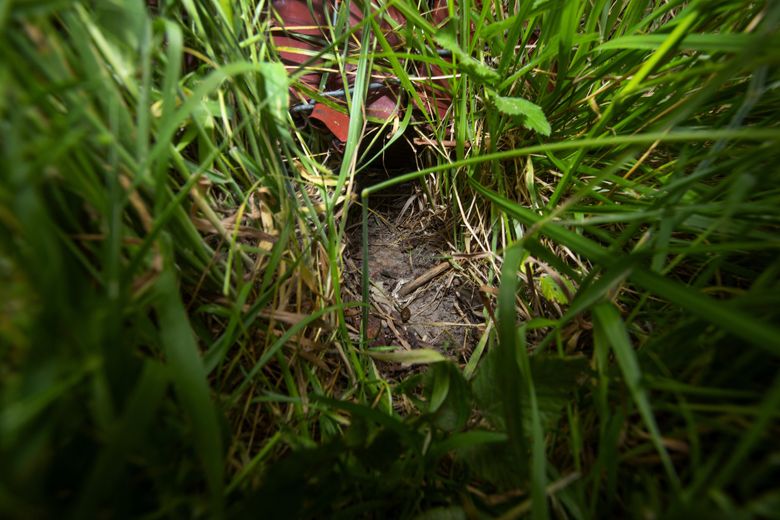
Perry Acworth, farm manager at the University of Washington’s Center For Urban Horticulture, calls this hole under a fence and pathway through the… (Ken Lambert / The Seattle Times)
King Bunny is aptly named.
WHICH, I ADMIT, pains me a little — because is there a name more ridiculous, more contradictory, more absurd on its face than “King Bunny”? Kings are rare, regal, at the top. Cottontails are common, skittish, with bottom-of-the-food-chain skills: feeding, breeding and getting eaten.
“They’re called ‘forest snacks’ for a reason,” says Sue Brennan, founder of Rabbit Haven, a no-kill shelter in Gig Harbor. (Her passion is feral rabbits — domestic specimens that have been dumped — but she knows about wild rabbits, too.) “One that manages to be savvy might live two or three years. You don’t see a lot of old cottontails.”
Uncommon age might account for King Bunny’s size. So far, he’s evaded the coyotes, hawks, eagles and owls that snatch up his kin around town. Even crows get in on the bunny feast. “It can be hard if you don’t have the stomach for it,” says Bobby McCullough, facilities and landscape manager at the sculpture park. “A crow flying away with a baby bunny making a terrible noise 100 feet up.” (Other rabbit species burrow, but a cottontail nest isn’t exactly the Fort Knox of the animal kingdom. They’re shallow depressions and mostly unguarded: Mothers, not wanting to attract predators, don’t hang around unless it’s feeding time.)
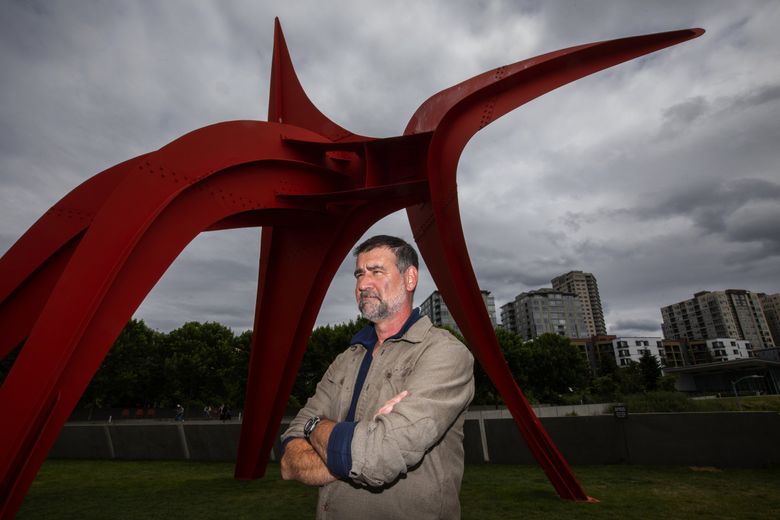
Bobby McCullough, manager of facilities and landscape at Seattle Art Museum’s Olympic Sculpture Park, says, “I’m over it,” when it comes to all the bunnies running around in the park. In the background is… (Ken Lambert / The Seattle Times)
The park’s S. floridanus population has spiked in the past three or so years, McCullough says, and bunny-noticers have divergent attitudes. Some feel protective, calling for a gardener to “Do something!” if they find a rabbit half-chewed by a raptor. Others regard the critters as a problem, suggesting McCullough set out traps and poison bait.
“As long as I’m working here, that won’t happen,” he says. “I get more joy from seeing them sunning themselves on the grass than frustration at chewed-down fern fronds.”
HUG THEM OR HUNT THEM: Like the little boy stalking King Bunny, many of us have our amygdalae tickled by rabbits. McCullough leans toward the hug-them camp. But some horticulturists root for the other team — the one with beaks and fangs.
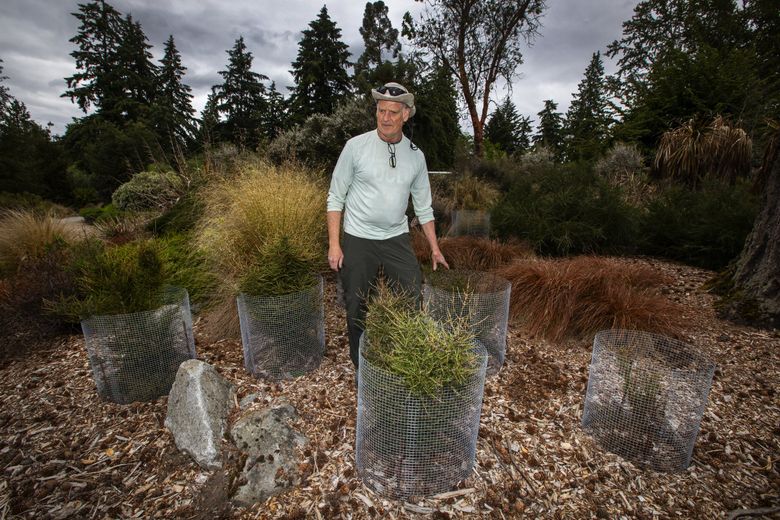
David Zuckerman, manager of horticulture at the University of Washington Botanic Gardens, stands with protective fencing around Coprosma plants at the Arboretum that were raised from seeds gathered from New… (Ken Lambert / The Seattle Times)
“For us, it’s always been insects and disease,” says David Zuckerman, who got his start at the Washington Park Arboretum in the 1980s and worked his way to manager of horticulture for the University of Washington Botanic Gardens. “Now we’re adding mammals to our list of pests. That was not the case six years ago.”
Since cottontails found their way into the Arboretum, they’ve been chewing up leaves, stems, even tree bark — including precious young specimens, some grown from the wild seeds of species that have been red-listed as threatened. Preservation and conservation, Zuckerman explains, are key functions of the Arboretum.

Rabbit damage to Cautleya is seen at the Washington Park Arboretum. (Ken Lambert / The Seattle Times)
“We’re maybe in the top five national collections for some oaks, magnolias and maples,” he says. “But the cottontails don’t discriminate.”
Just across Union Bay, UW Farm manager Perry Acworth has seen peas, beans, lettuce and other plants nibbled away — even at the half-acre Mercer Court Apartment gardens, which means rabbits have been climbing stairs to get to the chard.
That has cost UW Farm some revenue. Most of its income, Acworth says, comes from sales to UW food services, as well as households subscribing to weekly produce boxes. She’s deployed a variety of defenses: a solar-powered electric fence (though people keep stealing the batteries); marshmallowy row covers (rabbits chewed through them); thick, black plastic netting (ditto); and galvanized wire mesh (that’s been successful).
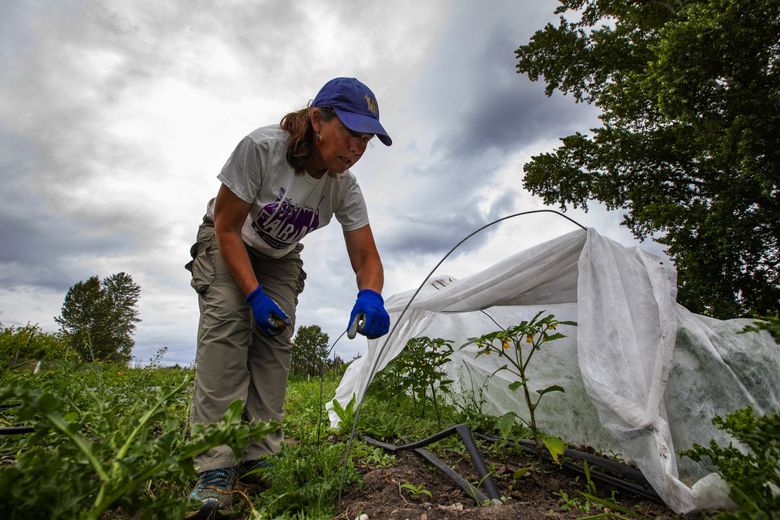
1 of 2 | Perry Acworth, farm manager at the University of Washington’s Center for Urban Horticulture, pulls back floating row cover to show how tomatillo starts are protected from rabbits. The fabric lets in… (Ken Lambert / The Seattle Times)
Zuckerman and Acworth have experimented with a fertilizer made from dehydrated blood, since rabbits fear the smell of carnage, and cultivate raptor-friendly habitats: keeping dead tree trunks and installing owl boxes. In 2019, Acworth worked with Indigenous students to install traditional rabbit snares. They snagged one and roasted it with Lakota squash and Makah Ozette potatoes.
“I’m just waiting for some chefs to say, ‘There’s cottontail on the menu,’ ” Acworth says. “That’s a whole underappreciated, underutilized, four-footed dinner hopping by!”
